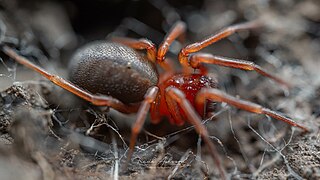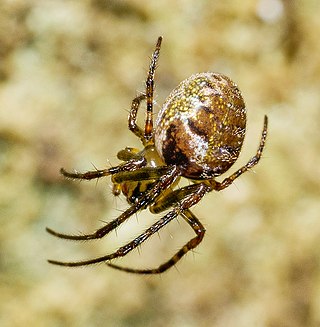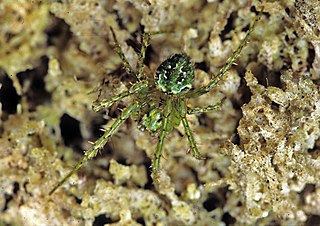
Trite is a genus of jumping spiders first described by Eugène Simon in 1885. Most of the 18 described species occur in Australia and New Zealand, with several spread over islands of Oceania, one species even reaching Rapa in French Polynesia.

Periegops is a genus of spiders with six eyes instead of the usual eight. It is the only genus in its family (Periegopidae) and has three described species. It was long considered to be a member of Sicariidae or Segestriidae until Raymond Forster elevated it to the family level in 1995.

Episinus is a genus of comb-footed spiders that was first described by Pierre André Latreille in 1809.

Celaenia is a genus of South Pacific orb-weaver spiders first described by Tamerlan Thorell in 1868.

Taraire is a small genus of Polynesian long-jawed orb-weavers. The genus was first described by A. Álvarez-Padilla, R. J. Kallal and Gustavo Hormiga in 2020, and it has only been found in New Zealand. They build vertical orb webs near forest floors, and can be found resting in the center. The genus name is a reference to Beilschmiedia tarairi, the native New Zealand tree that they are commonly found in.

Elizabeth Bangs Bryant was an American arachnologist. She worked at the Museum of Comparative Zoology in Cambridge, Massachusetts and was a close acquaintance of James Henry Emerton. She is best known for her studies of the spiders of New England and the Caribbean.

Trite auricoma, commonly known as the golden-brown jumping spider, is a species of jumping spider endemic to New Zealand.

Tekella is a genus of South Pacific araneomorph spiders in the family Cyatholipidae, and was first described by A. T. Urquhart in 1894.

Matachia is a genus of South Pacific intertidal spiders that was first described by R. de Dalmas in 1917. Originally placed with the Psechridae, it was moved to the intertidal spiders in 1970.

Nanometa is a genus of long-jawed orb-weavers containing the fifteen species. It was erected by Eugène Louis Simon based on the type specimen of Nanometa gentilis found in 1908. It is included in a clade of its own defined by nine morphological synapomorphies, along with the genus Orsinome.

Cryptaranea is a genus of South Pacific orb-weaver spiders first described by D. J. Court & Raymond Robert Forster in 1988.
Laestrygones is a genus of South Pacific araneomorph spiders in the family Toxopidae, and was first described by A. T. Urquhart in 1894.

Periegops suterii is a species of spider in the genus Periegops that is endemic to the South Island of New Zealand.

Diaea ambara is a species of crab spider that is endemic to New Zealand.

Steatoda lepida is a species of Theridiidae that is endemic to New Zealand.

Sidymella angularis, is a species of crab spider endemic to New Zealand.
Haplinis diloris is a species of sheet weaver spider endemic to New Zealand.
Haplinis mundenia is a species of sheet weaver spider endemic to New Zealand.
Tekella nemoralis is a species of Cyatholipidae spider endemic to New Zealand.

Rhomphaea urquharti is a species of cobweb spider that is endemic to New Zealand.















